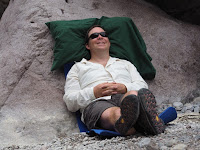 |
| Steinbeck Canyon |
The Crew of Sea Rover II have had a few adventures this last
week. Last year when we were in Puerto
Escondido in December, we hiked a bit of the Steinbeck Canyon, which is a
lovely slot canyon up in the Giganta mountain range about two miles from the
marina. The canyon has beautiful rock
formations and is full of fresh water pools in the fall after the summer
rains. After last year’s hike, we talked
about how neat it would be to hike further into the canyon and spend the
night. So, this year we brought our tent
and some camping gear with the intention of doing just that!
 |
| Rock wall; end of the line for most hikers... but not us! |
Tanya and Jay from s/v Kialoa joined Gary and I on our “land”
adventure up the canyon. We left the
boats tied up to mooring balls in Escondido and left the dinghy locked to the
dock. We took minimal gear (tent,
sleeping bags, thermarests, a few clothes - Tanya brought a pillow!) and Jay carried most of the food (he’s
young and strong). It used to be a
relatively easy hike all the way up the canyon, but a hurricane a few years ago
caused a change in the boulder configuration such that some climbing moves are
required to get past the rocks a mile or so up the canyon.
 |
| Sketchy move up the rock wall - there is a 15 foot drop below |
This is where I (and most other people who do
the hike) stopped last year, while the others hiked/climbed on. This year Gary was determined to get me up
there! With a lot of help and coaxing
from Gary and Jay (both mountain goats), Tanya and I completed the 4 “sketchy”
sections required to move higher up the canyon.
Tanya had made the moves last year, but was still happy for the extra
support again this year. Thanks Jay and
Gary!
 |
| Pool just above camp |
The efforts were worth it.
As there hasn’t been as much rain this year, the pools weren’t nearly as
full of water. As such, most of the
pools started just above the “sketchy” section.
We stopped to dunk our heads in the water and have a quick lunch, then
continued up the canyon.
 |
| Camp |
 |
| Gary lounging in camp with Tanya's pillow |
Humming birds, yellow butterflies and frogs. Upon their return we played cards by headlamp, then made a campfire and ate all the food Jay had hauled up (the makings for quesedillas, chocolate, fruit etc). It was a feast! We talked long into the night then went to sleep under the bright moon.
 |
| Stick bug |
We didn’t see any wild animals, but the place was crawling
(literally) with daddy long leg spiders.
Tanya had to remove 8 spiders from her tent before she could go to sleep
as she’d accidently left the tent flap open.
Oops.
Our only other visitor was
a stick bug, which climbed up Jay’s arm, then realizing he’d made a mistake
promptly turned himself into a stick!
We enjoyed swims in several of the pools on the way down,
and got through the “sketchy” areas again with Gary and Jay’s help.
Tanya and I avoided the worst of the “sketchy”
climbing moves by climbing down a small waterfall and swimming across one of
the pools instead. Much easier and less
stressful for all involved! The day was
topped off by a stop at for ice cream on the long walk back to the marina.
We left Puerto Escondido the next day and sailed down to
Isla San Francisco, one of our favourite spots.
While we were there, we put together my new Feathercraft folding kayak. After an intense hour of figuring out how it
went together, I was paddling around the bay.
We left early the next morning (ie, 4am) to sail to Ensenada
del Candeleros on Isla Partida, the island close to La Paz. We spent the day snorkeling the reef and
cleaning the bottom of the boat, then left the anchorage at 11pm to sail to La
Paz. We were hoping to spend the entire
night in the anchorage, but a Coromuel blew in (nasty nighttime west winds that
cause huge waves to be pushed into all the bays in the Islands) and we
literally got bounced out of bed. We had
a quick sail down to La Paz even though there was only 5-7 knots of wind and we
were double reefed! We couldn’t seem to
slow the boat down. She even sailed
downwind in less than 4 knots of wind, which is very difficult for us to do
under normal conditions. Crazy sail! Anyway, we arrived at the La Paz channel
mouth at 4:15am and decided there was enough light to enter. We anchored at 5:15am and then got some much
needed sleep before I had to “go to work”.
We’ll be here for the next week doing some boat projects and
catching up with friends, and then will look for a weather window to cross over
to the mainland side. Puerto Vallarta,
here we come!














